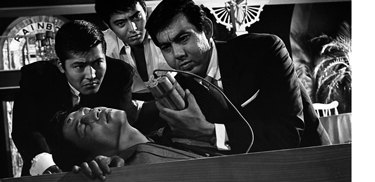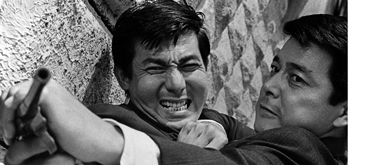
 |
|
|
|
A slick gangster vehicle for Nikkatsu Studio's popular '60s star Jo Shishido, 1967's Massacre Gun is an unpretentious by-the-numbers tale of craven treachery and reprisals. It's the second film from director Yasuharu Hasebe, made very much to the visual formula of Seijun Suzuki, as seen in the more widely-known Branded to Kill. Perhaps less visually exotic than Suzuki's film, Massacre Gun has no trouble dishing out scenes of brutality. Gang loyalty clashes with family honor, resulting in the expected high body count.
Ryuchi Kuroda (Jo Shishido) holds a high roost in the criminal gang of Akazawa (Takashi Kanda), who asks him to prove his loyalty by murdering his own sweetheart. Kuroda's younger brother Saburo (Jiro Okazaki), a promising boxer in Akazawa's stable, quits in protest. The gangster boss has Saburo's hands broken, ending his boxing career, and asks Kuroda to apologize for both of them. Kuroda instead resigns and with Saburo and his third brother Eiji (Tatsyuya Fuji), begins to
Jo Shishido is of course the Japanese star with a gimmick that western audiences find hard to believe: he underwent cosmetic surgery to place implants in his cheeks, giving him a puffy appearance somehow meant to look attractive. The face job makes Shishido less expressive, even comical. In some shots he looks like a chipmunk stuffing himself with nuts, and in others a lot like actor Jack Webb, but with terminal mumps. I don't believe that Japanese ideas of beauty are that different from ours, and they certainly can point to American celebrities with eccentric ideas about their appearance. But Shishido comes off as rather extreme, just the same. By contrast, co-star Jiro Okazaki looks like a teenage rock 'n ' roll idol, with sort of a Michael Callan vibe. His looks certainly translate between the '60s cultures, as does Saburo playing of drums after hours in the nightclub. Yasuharu Hasebe's style is rather standard for Nikkatsu at the time, which indicates a careful use of clean modern interiors spread across the wide NikkatsuScope screen. People are vertical but objects are all horizontal, lending a nice visual background for the constant jazz score by Naozumi Yamamoto (the Tora-San Series). The editing often cuts from extreme close-ups to equally extreme wide shots. The most frequent narrative event is one gang's invasion of the other's space (a club, a business, headquarters, the boss's home) to make threats, break up furniture, kidnap somebody or start shooting. But this never happens when our heroes lounge about smoking and listening to the cool, smooth jazz music while contemplating the depthless enigma of 'giri.' The key to survival in a Yakuza film 1 is therefore to keep the music going, like 24-7, man. 
The women in the film aren't very memorable. We see brief nightclub performances, a male-female erotic dance team, and a tall stripper. All are Anglos.Shirasaka's wife dreads the idea of her husband and his best friend becoming enemies, and secretly admires Kuroda. Saburo's girlfriend criticizes his new rich-guy attitude, zipping around in his new boat and sports car. After our 'hero' Kuroda shoots his main girlfriend to death point-blank in a car, we get the idea that women are expendable in this play-with-guns boy's club of a movie. Why does Kuroda become all vengeance-driven when his brother is harmed, when he calmly accepts the mission to murder his own sweetheart? Two wrinkles add to the interest. As the gang war heats up, a gun salesman visits both sides. When he meets resistance, he offers to sell strategic information along with his hardware. I've always assumed that the manufacturers of military weapons, jet planes, missiles, etc., play the exact same games with their clients, especially if they're selling to both sides. This cheerful guy is almost as interesting as the gun salesman in Taxi Driver. 
Helping Saburo with his musical jam sessions is his best buddy Chico (Ken Sanders), a mixed-race cool cat who sings a couple of songs in Japanese (and also appears in one of director Hasebe's Stray Cat Rock movies). I found this tangential web reference to Sanders. The history behind these Nikkatsu actors is interesting. Sanders was born in 1946, presumably of an American-Japanese romance during the occupation. Actor Tatsuya Fuji was born in Beijing in 1941, in occupied China. In his interview, Jo Shishido says that his family's money came from the period of the Annexation of Manchuria. Hasebe stages his final scene on a vast windblown freeway system under construction, where Kuroda waits in ambush with a high-powered rifle. The action is well directed, making good use of the bleak setting. This particular brand of gangsterism doesn't seem very practical. Boss Azakawa seems bent on forcing his own best men to start a war. Nobody ends up happy, or even alive. Massacre Gun's best scenes are the relaxed 'lounge' sequences, with Kazue Nagatsuka's camera roaming the dark nightclub while Ken Sanders sings a sad song in Japanese. 
Arrow Video's Blu-ray + DVD of Massacre Gun is being released in several regions at once, so check your local outlet before buying abroad. The HD image (the first B&W Nikkatsu genre film I've seen in Blu-ray) is sharp and detailed, with the low-contrast look we remember from theatrical screenings. The audio is quite good. Since about a third of the film is backed with Yamamoto's cool jazz music, I'm going to put it on my self for background audio when I work. Arrow has come up with some really good extras. Jo Shishido appears for a lengthy interview. At age 80 he remembers his crime film heritage as one big movie ("I can't tell one from another") although he does have his favorites. When asked how he became a film star, he repeats stories about playing with guns and swords as a kid, crashing dad's truck, etc. His cheeks look very hollow now. If I knew more about plastic surgery, perhaps I could guess whether his augmented cheeks were accomplished with injections that would be slowly absorbed, or actual implants that had to be removed. He looks pretty good. 
Film expert Tony Rayns gives a lengthy oral history of the Nikkatsu Company in another long interview featurette. An excellent speaker, Rayns works his way through the decades, talking about the company's various financial problems, its big name attractions and the various genres it exploited, all the way to the soft-core sex films of the 1970s. A gallery of ad art is followed by a trailer that to me looks composed of alternate takes and angles. It's like we're watching the other movie of the same name. Dour dedicated Jo Shishido makes for a pretty odd gangster hero -- he's dour, unimaginative and un-romantic; he and does a lot of staring downward, wondering why the criminal life isn't more fun. But with a gun in his fist he's a handy Joe indeed.
On a scale of Excellent, Good, Fair, and Poor, Footnote:
1. Is this a Yakuza film? I see no tattoos, formal greetings, superstitious rituals or missing fingers. Nobody uses blades. What kind of Yankee-faced outfit is this, anyway?
The version of this review on the Savant main site has additional images, footnotes and credits information, and may be updated and annotated with reader input and graphics.
Review Staff | About DVD Talk | Newsletter Subscribe | Join DVD Talk Forum |
| ||||||||||||||||||